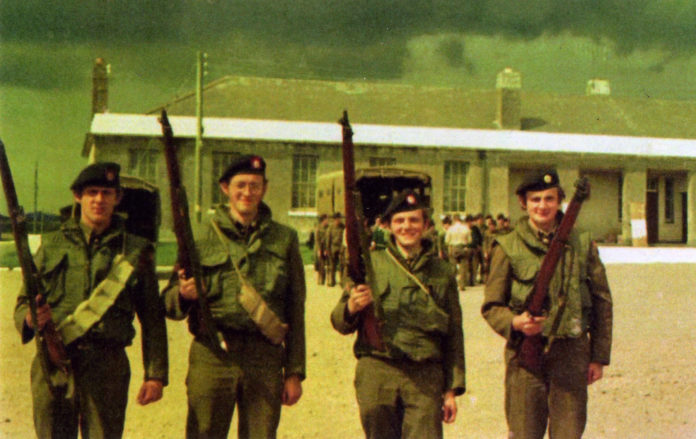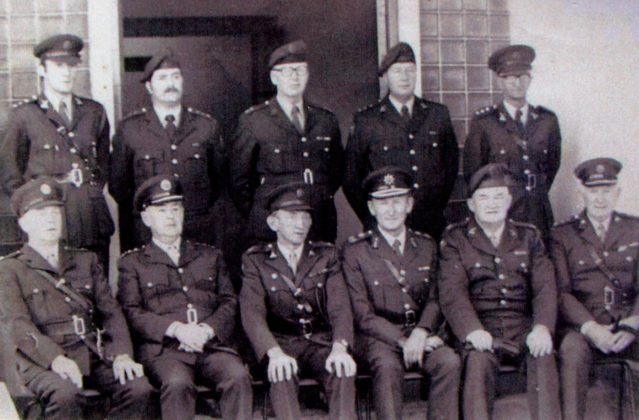
By Denis Morgan, Midleton
“We all have our own time machines, one is called memories, they take us back in time. The other takes us forward, these are called dreams” – Jeremy Irons, actor
I suppose that in all armies, the highlights of a recruit’s life during his 18 weeks infantry training course is the firing of the weapon and weapons systems that he has been training with.
The Irish Army of 1971, which I was a member of, was no different and in the following months, weeks, days and hours of intensive training we as a class passed our T.O.E.T’s (tests of elementary training) and were considered fit to be left loose on the Kilworth Ranges to fire the practices associated with the F.N.7.62 Light Automatic Rifle, our personal weapon and the 7.62 MAG machine gun, the section fire weapon.
A beautiful weapon, the 7.62mm F.N rifle was a much superior firearm than the British standard assault rifle, the SLR (Self Loading Rifle). Magazine fed (20 rounds), gas operated, air cooled, it was accurate up to 600 metres, its best killing range was 100-200 metres. Fitted with a fold up/down sight, you could launch an anti-tank round (called an Energa) at armour up to 75 metres from the combined grenade launcher/flash hider screwed to the muzzle of the barrel.
It could also fire automatic, in bursts and when your bullets ran out, you could fix a bayonet to the top of the rifle barrel for close quarter fighting. We spent hours practicing bayonet fighting, first in the gym against the Ranger Corporal instructor, who used a bayonet stick to provoke reaction from us and then we were let loose to practice on scarecrow type dummies scattered behind various types of cover and in trenches.
“IT’S GOT TO BE HARD TO BE GOOD!”
The bayonet is a thick slab of solid steel that is designed to punch through bones like they are made of paper mache. It has rivets down the side, so that when it stabs it doesn’t get stuck. The blade itself is so heavy and strong you could stab it into a tree and it wouldn’t break, truly a frightening weapon. Carried out properly, bayonet fighting then was as physically hard and demanding as unarmed combat, boxing training or going over the assault course in fighting order.
The Ranger Corporal had ways of encouraging us when spirits and limbs were flagging and had some weird and wonderful sayings like “you got to be fit to fight”, “only the fittest survive”, “train hard, fight easy” (some joke!) and his favourite “it’s got to be hard to be good!”
In order to strengthen us up for bayonet fighting (especially our arms) our sergeant, a tough, hard Congo veteran from the Northside of the city and also a physical training instructor, introduced a loathsome form of PT called rifle strengthening exercises.
The object was to toughen the wrists and arms of the weedy (in his eyes us) by having them whirl the rifle around the head, hold it at arms length and twist it about and eventually grasp it by the extreme tip of the muzzle and lift it with a straight arm horizontal from the body.
Sheer torture, but even ‘Slim’ – so nicknamed because he was tall and could hide behind a brush, a lad from Spangle Hil – came to appreciate the benefits of this weird form of bodybuilding.
Bayonet fighting was all about sheer naked aggression and the instructors did their utmost to instill the fighting spirit into the platoon, most of whom were teenagers who in a few short months would be engaged on anti-terrorist operations on the Irish border – 441 kilometres and 291 crossings. (At that point in time the army were 3,500 under strength and were in the process of forming up 3 border battalions and a motor squadron (Cavan, Monaghan, Dundalk, Donegal, Longford).
In a little over a year, some of the same platoon would be serving on peace keeping duties in Cyprus (pre Turkish invasion) or in the Sinai Desert (Yom Kippur War aftermath).
Some of the lads who were sent to the border in 1971/2 never returned to the Southern Command or to Collins Barracks, opting to stay on the border joining the newly formed 27th Battalion (Dundalk, Castleblaney, Gormanston) or the 28th Battalion (Finner, Lifford, Rockhill).
They would be joined a few years later by the 29th Battalion (Cavan, Cootehill, Monaghan) and also by the 4th Motor Squadron (Longford, Ballyconnell). Attached to these units were fixed wing aircraft, helicopter, bomb disposal and specialist search teams. It was an exciting time to be a soldier. And soldiers from Cork backboned those early border units.
‘DEAD NUTS ON ACCIDENTAL SHOOTINGS’
The 7.62 MAG machine gun, or GPMG, was truly an awesome weapon with a cyclic rate of fire. 600-1,000 rounds per minute, it could fire tracer, ball ammunition and armoured piercing with enough force to punch through a brick wall.
Weighing about 24lbs and 200 round belts, another 12lbs, it was not a light weapon to carry but had the capacity to wreak havoc on an enemy, win the fire fight and engage in close quarter battle; if mounted on a tripod, used as anti-aircraft defence or to establish a fire zone up to 2,000 metres. Any accidents with the MAG machine gun – or GPMG as it’s called – and you would be lucky to lose only an arm.
The weapons issued to us were on the basis of trust and to treat them in a light-hearted manner was an unforgivable sin. To misplace, or worse still, to loose your weapon, its sights or any of its parts was a court martial offence and you could ‘get your ticket’.
To fire a round accidently was a grievous offence and was punished severely. The Irish army were dead nuts on accidental shootings, there would be a casualty rate of 12% on the Lebanon mission of accidental shootings.
We threw hand grenades – the Mills 36 with a 7 second time fuse. The Mills 36 looked like an Easter egg and was designed to kill or seriously wound. The grenade range in Kilworth was a system of concrete trenches consisting of the priming bay, the throwing bay, a bunker and a small tower behind the trenches where the officer could overlook proceedings.
N.C.O’s usually took charge of the priming and throwing of the grenades, 2 per man. The idea was to throw the grenade over the parape of the throwing bay into invisible circles 20 to 30 metres to your front, scream ‘Grenade’ and duck down. The biggest danger was if you dropped the grenade and the safety lever flew off, then the grenade was armed and you had 6 seconds to fling yourself behind the reinforced safety wall. If you didn’t make it then they would be scraping you off the ground.
Accidents have happened, a young officer lost his life in an incident with a live grenade in a range up the country.
I probably threw about a dozen grenades in the army, Mills 36 and the grenade that replaced it in 1973, the Argus 69 H.E grenade. With just a 4 second fuse, it was a grenade that contained 3,500 small ball bearings in a fragmentation jacket inside a casing and had a 360 degree burst from a point of impact and a danger area up to 100 yards.
It was also deadly for setting booby traps on trip wires, doors, gates and toilets (flush the toilet by pulling the chain and you released the safety pin, arming the grenade and it was all over). The Australian Army had used this type of grenade in Vietnam, as had Rhodesian in Africa.
‘A CHANGE OF UNDERWEAR KIND OF DAY’
The biggest scare that I got with a grenade was when an FCA recruit dropped a grenade in the throwing bay on the Kilworth grenade range during annual camp in 1976. It wasn’t so much that he dropped it, it was just that he threw it up okay, but alas no distance and after the ‘ping’ of the safety lever flew off, the little green Easter egg with the yellow or red band to my horror started to descent to mother earth in the throwing bay, where there was myself, the FCA recruit and an FCA officer. Now 4 seconds is not an awful lot of time but we managed to get behind the safety wall before it blew. This was followed by two more explosions as the blast from our grenade ignited 2 more grenades in the priming bay.
Then there was a deadly silence. The training officer came down from the tower to inspect the damage. No casualties, just the two windows on the left hand side of his car which was parked on the road behind the grenade range were in pieces.
But anyway, we picked up the bits and pieces of the other damaged grenades and detonators and began to walk out 20 yards with them and using the demolition box, we dug a small hole, inserted a foot of safety fuse into a detonator, fitted the detonator to a gun cotton (explosive) primer, put the bits and pieces into the hole along with the prepared charge and lit the fuse – this gave us 30 seconds to walk back and wait.
Following a massive explosion (at least I thought it was anyway!) we were back in business and continued throwing. All in a day’s work!
We undertook the precaution of testing the safety fuse – all in all I suppose it was a change of underwear kind of day. That evening I started to get a ringing in my ears and went a bit deaf. A trickle of blood had dried around the ear, so I went to the medic. He cleaned it up with some olive oil and cotton wool and advised me to have a few pints in the ‘Glocca Maura’ or the ‘Blue Dragon’ which would take away the ringing noise.
This I did and while the ringing disappeared, it was replaced the following morning with a ferocious headache that I tried to cure with a ‘Kilworth Breakfast’ (an aspirin; glass of water, a trip to the toilet and a fag).
THE PERILS OF CHECKPOINTS
Now probably the most dangerous, inhuman anti personnel device ever made and extensively used by Israel against civilian targets, was the cluster bomb delivered by military jets ejecting large rockets carrying more than 600 baseball sized bombs in each missile, purposely to kill and maim as many souls as possible along the wadis and hills of South Lebanon, where thousands of these unexploded devices were scattered all over and probably the worst nightmare for a check point/post commander – apart from a contact situation – was for a young Lebanese child to appear with 1 of those bombs looking for a reward.
A good friend of mine was very unlucky with grenades whilst on active service. One incident occurred on Post 620 Alpha – a containment position on the edge of the village Brashit. An Israeli militia man, a member of the notorious LAUI’s (Lebanese armed and uniformed by Israel) high on Arak (a Lebanese drink, coloured white rocket fuel) and the weed Lebanese gold, when refused entry through this checkpoint after curfew, pulled a H.E. grenade from his pocket and threatened to explode it unless he gained entry.
BLIND MAN RIDES INTO SUNSET
The other incident occurred at a checkpoint at the Yatar/ Kafra junction with a LAUI dying as a result of a grenade attack by the Islamic Resistance – they used a phosphorus bomb. Anything could happen at a checkpoint. A friend of mine, a hard tough soldier who had served in the desert and who had quite a short fuse, was manning a checkpoint when a blind man armed with a sub machine gun (I kid you not!) refused to surrender his weapon and was denied entry through the checkpoint.
The blind man threatened to waste the NCO and his two sentries, waving the gun around and cursing all and sundry in Arabic. Straight and to the point, my friend told the Arab to ‘F*** off’ several times in Arabic and English and he also had some other Arabic swear words he used and at the same time, ordered the sentry on the sandbag position to cock (load) the general purpose machine gun, which makes a fair old rattle.
Now the Arab gentleman might have been blind, but obviously he wasn’t deaf and he retreated loudly cursing the lads on the checkpoint, their fathers and sons, then mounted his donkey and rode off into the sunset.
Timor Goskel must have thought it very amusing when he submitted his operational report to UNHQ New York. Goskel was the UNIFIL press information officer.
The most daunting test faced by a young soldier must be ‘Battle Inoculation’ or Battle Practice. This involved being fired upon by 2 general purpose machine guns deployed in the sustained (heavy) fire role at the rate of 600 to 1,000 rounds per minute. Mounted on a tripod, the range of these heavy machine guns was over a mile and a 10 second burst delivered a lethal cluster of over 100 rounds of the target setting a beaten (killing) zone from which nothing could emerge over ground, its massive firepower capable of destroying walls of rocks in their path.
In Kilworth, you had protection in a dried up riverbed (called a wadi in the Middle East and Africa); in the Glen of Imaal you were marched 120 at a time into a huge trench.
A BAPTISM OF FIRE
The battle exercise started with a huge explosion going off in the distance. For about 30 seconds there would be an uneasy silence. Out on the ranges, the Detachment Commander roars out his orders to the machine guns’ crews. No 1 FSG (fire support group) 300 (range in metres to target) ‘Centre of Arc’ (indicating the target) Trench ‘Lay Rapid Fire’. The no 2 feeds belted ammunition into the gun as the tracer arches high over the target.
Adjusting the machine gun elevation drum, the no 1 would fire off another burst. Belted 7.62 ammunition rips through the receiver of the gun from the left, spent cartridges spewing from the metallic ring as it rained into the ground drowned out as the muzzle of the gun barks, NATO standard rounds travelling at 3,000 feet per second churning out in a relentless irresistible rattle.
In due course, the barrel would turn white hot, replaced by the No 2, then the second gun would go into action.
Down in the trench all hell would break loose. A massive barrage going on overhead with the constant cackle of machine gun, as bullets whiz overhead and the dull thud of bombs exploding on each side of the trench. The worst sensation is the violent, sickening vibration which shakes the bones with a huge weight pressing down on the entire body.
The ground shook, a gigantic invisible hand pressing down on your stomach, the air would reek of cordite, petrol, smoke, white dirt, grass and top soil showered the trench. Outside the trench, plumes of black smoke shooting up overhead. The Ordnance Corps and the Assault Pioneer Platoon of the Engineer Corps setting off explosive charges simulating land and anti personnel mines and IED’s (Improvised Explosive Devices).
The ordeal would last 15 minutes, a baptism of fire of sorts for young soldiers and a taste of what they would have to endure time and time again, in the hills and along the wadis of South Lebanon.
FIRE AND SMOKE, SHOCK AND AWE
Over the years there would also be plenty of drama on Kilworth’s mortar, anti-tank, Energa and hand grenade ranges with misfires (bombs that fail to leave the barrel of mortar and anti-tank weapons), UXBs (unexploded mortar bombs and Energa anti-tank grenades, armed and highly dangerous), blinds (unexploded hand grenades) and on one occasion, 4 mortar parachute illuminating (flare) shells, launched into the Kilworth skies, before descending and plunging over the tree line of Glenseskin Wood, 50 metres beyond the range/forestry boundary line, flaming parachute silk and burning magnesium flare pots crashing into the canopy of conifers, fir and spruce.
Fire and smoke, shock and awe at Kilworth’s School of Bangs and Battle Inoculation.










